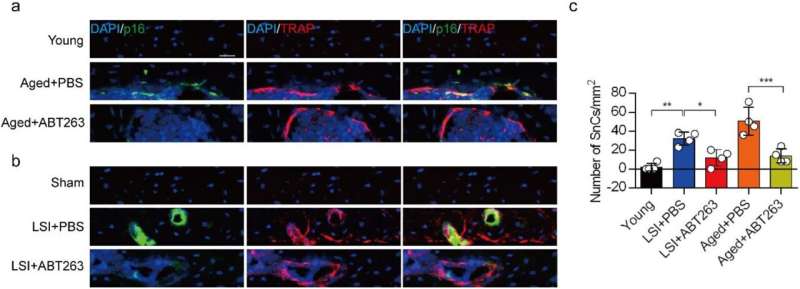This article has been reviewed according to Science X's editorial process and policies. Editors have highlighted the following attributes while ensuring the content's credibility:
fact-checked
peer-reviewed publication
trusted source
proofread
Drug that kills off sleeping bone cells could treat lower back pain

An existing drug that targets senescent, or sleeping cells could provide the answer to treating lower back pain, according to a new study.
The research, published Nov. 13 as a Reviewed Preprint in eLife, advances our understanding of the role of senescent osteoclasts—cells that break down and remove damaged bone tissue—in the development of lower back pain, which affects 8 in 10 people at some point in their lives. eLife's editors say the study provides compelling evidence that an existing drug, Navitoclax, can eliminate senescent osteoclasts in mice and, in doing so, markedly reduce spinal pain.
Osteoclasts resorb and break down bone tissue as part of the body's natural bone remodeling and maintenance process. When these cells become senescent, they no longer function properly, which can lead to problems with bone maintenance and repair.
"It's previously been shown that senescence promotes age-related musculoskeletal diseases such as osteoporosis, and removing senescent cells from degenerated vertebral disks restores the intervertebral disk structure," explains lead author Dayu Pan, Postdoctoral Research Fellow in the Departments of Orthopedic Surgery and Biomedical Engineering, Johns Hopkins University School of Medicine, US.
"We previously found that osteoclasts cause the endplates between each vertebra and disk to become porous, allowing infiltration of new nerves that cause lower back pain. In this study, we set out to test whether this is caused by a specific group of senescent osteoclasts and whether eliminating these osteoclasts could reduce the pain."
The research team first set out to identify whether senescent osteoclasts were present in the porous endplates of vertebrae in mice with two types of spine hypersensitivity—one caused by aging and the other caused by lumbar spine instability.
They tested for the simultaneous presence of two markers within the bone—"TRAP," which is a hallmark of osteoclasts, and p16, used to identify senescent cells. In both types of spinal degeneration, they saw a strong association between the presence of senescent osteoclasts and the degree of degeneration and spine hypersensitivity.
Next, they explored whether a drug called Navitoclax, which targets senescent cells, could eliminate senescent osteoclasts and reduce spinal hypersensitivity. As hoped, the treatment caused a significant reduction in senescent osteoclasts compared to untreated mice, as well as reduced pain and increased activity in mice with both types of spine degeneration.
Spinal scans and microscopic examination of bone tissue confirmed there was reduced degeneration and porosity within the endplates, as well as reduced separation between them, in the treated mice. This suggests the anti-senescence drug can prevent the degeneration and remodeling associated with aging or spine instability.
Finally, because porous endplates allow new nerves to grow into the endplate bone, causing sensitivity, the authors looked at whether senescent osteoclasts play a role in this process. They tested for two markers of nerve fibers in the endplates of mice, as well as markers of new blood vessels, and found that mice treated with the anti-senescence drug had fewer nerves and blood vessels within the endplate than untreated mice.
This suggests there is an ongoing dysfunctional production of new bone tissue within the spinal endplate in the aging or injured spine, and that treatment to remove the senescent osteoclasts could halt this process.
Taken together, these findings suggest a potential role for anti-senescent drugs such as Navitoclax in treating spine pain, but this would need to be further evaluated in clinical trials before the treatment could be used in patients with lower back pain.
"Osteoclasts are the principal bone-resorbing cells essential for bone remodeling and skeletal development, but we have shown that osteoclasts in the endplate of the spinal column undergo senescence, leading to nerve growth and spine pain," concludes senior author Xu Cao, Professor of Orthopedic Surgery, Department of Orthopedic Surgery and Department of Biomedical Engineering, Johns Hopkins University School of Medicine.
"Our findings suggest that depletion of these senescent osteoclasts, perhaps by use of existing drugs, could represent a new strategy in the treatment of lower back pain."
More information: Dayu Pan et al, Senescence of endplate osteoclasts induces sensory innervation and spinal pain, eLife (2023). DOI: 10.7554/eLife.92889.1





















